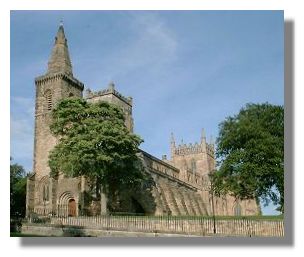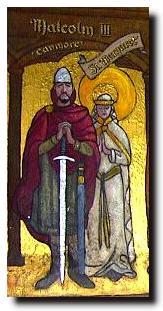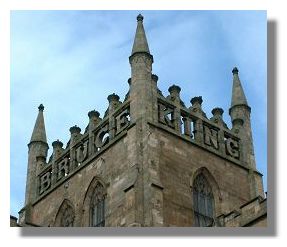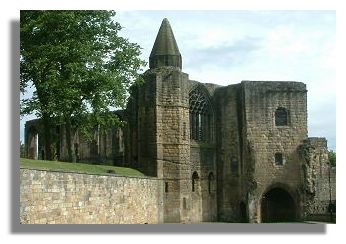
11th Century Priory
 King Malcolm III (known as "Canmore") and his wife Margaret were married in Dunfermline in 1070 and it was Margaret (later canonised as St Margaret) who established a Benedictine priory there before the end of the 11th century. However, it was their youngest son, when he became King David I, who enlarged the priory to the status of an abbey during his reign from 1124 to 1153. Because of St Margaret, Dunfermline became a place of pilgrimage.
King Malcolm III (known as "Canmore") and his wife Margaret were married in Dunfermline in 1070 and it was Margaret (later canonised as St Margaret) who established a Benedictine priory there before the end of the 11th century. However, it was their youngest son, when he became King David I, who enlarged the priory to the status of an abbey during his reign from 1124 to 1153. Because of St Margaret, Dunfermline became a place of pilgrimage.
The abbey became one of the richest in the country and it established satellite property in other parts of Scotland, as far north as Morayshire and Dornoch and south to Lothian and the Borders. A chapel to St Margaret was completed in the middle of the 13th century and her body was moved to the shrine there. Her husband, King Malcolm III was moved at the same time, apparently because it proved to be impossible to move one without the other - Margaret died a few days after her husband and eldest son had been ambushed and killed at the Battle of Alnwick, in Northumbria.
In 1303, King Edward I of England ordered the abbey and its buildings to be destroyed as part of his attempt to subdue Scotland. As part of his reconstruction of the country, King Robert the Bruce contributed to the rebuilding of the abbey. He was buried in what was described as a magnificent marble tomb in Dunfermline Abbey.
Burial Place of Kings

In addition to King Malcolm III and his wife Margaret, a number of other kings, queens, princes and princesses were buried in Dunfermline Abbey. Three of King Malcolm III's sons - King Edgar (1107), King Alexander I (1124) and his queen Sybilla and King David I (1153) were all interred there as was David's grandson, King Malcolm IV (in 1165). Later, King Alexander III (1286) and his queen (another Margaret) were buried at Dunfermline.
But it is King Robert I (The Bruce) who is commemorated most in recent times at Dunfermline Abbey with the words "King Robert the Bruce" carved round the central tower. This was built in the early 19th century after the original tower fell in a violent storm. During restoration work, human remains considered to be those of King Robert the Bruce were found and reburied in a position later occupied by the pulpit. There is a commemorative plaque and spotlights marking the spot. At his request, King Robert's heart was taken on a Crusade by James Douglas. In a fight against the Moors in Spain, Douglas was killed and the embalmed heart was returned to Scotland. It was buried in Melrose Abbey.
Dunfermline Palace
 In addition to the abbey itself, over the years extensive monastic buildings were built to the south of the abbey church. with cloisters, dormitories, refectories and a calefactory, or warming house. This was the only part of the building which had any heating, which must have made life very hard for the Benedictine monks who lived there.
In addition to the abbey itself, over the years extensive monastic buildings were built to the south of the abbey church. with cloisters, dormitories, refectories and a calefactory, or warming house. This was the only part of the building which had any heating, which must have made life very hard for the Benedictine monks who lived there.
Over the centuries, as a result of royal patronage, the abbey flourished and expanded. An important role of the building was to provide accommodation for important visitors, including the reigning monarchs. A large guest house was built and King James VI's wife, Anne of Denmark, was granted the guest house in 1589. It was remodeled to provide a palace for her use. The future King Charles I was born there in 1600.
The abbey ceased to function as such after the Reformation of the church in Scotland in 1560, but fortunately the nave of the church continued to be used as the local parish church. As a result much of the abbey has survived to this day.



